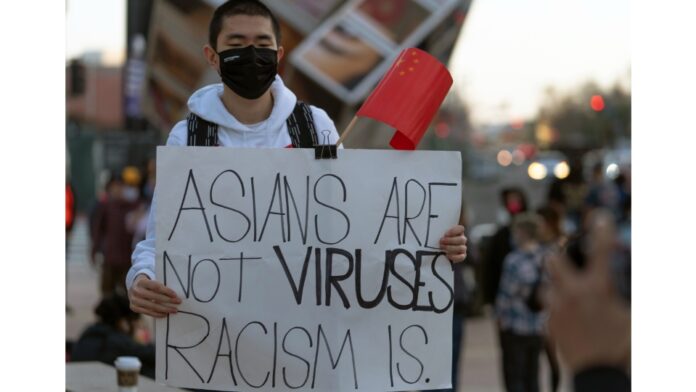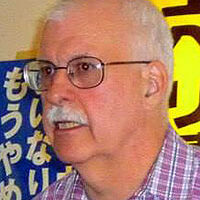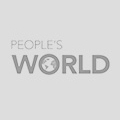A demonstrator participates at a rally ‘Love Our Communities: Build Collective Power’ to raise awareness of anti-Asian violence in Los Angeles, March 13, 2021. | Damian Dovarganes / AP
U.S. foreign policy can have great impact on people’s daily lives here at home, and U.S. policy toward China is a prime example. When the U.S. conducts a hostile, anti-China foreign policy, there is increased racism and repression in the Asian and Chinese American communities in the U.S.
On the other hand, when relations with China are good, such as during World War II or the 1980s, mainstream media depicts Chinese Americans as friendly, patriotic, and the “model minority.”
As U.S. imperialism’s new Cold War against China heats up, familiar patterns are repeating themselves under new conditions.
Historical background
The Central Pacific Railroad employed large numbers of Chinese immigrants to build the western half of the Transcontinental Railway, completed in 1869. However, no Chinese workers were invited to the golden spike ceremony at the completion of the project. Especially with the overthrow of Reconstruction, racist attitudes prevailed, and the Chinese Exclusion Act was signed in 1882. This blocked Chinese workers from entering the U.S.; it was the first anti-immigration legislation targeting a specific ethnic group or country of origin.
In 1913, the novel The Insidious Fu Manchu was a hit and became a cultural icon full of racist stereotypes about the ever-lurking, insidious Dr. Fu. But during the 1930s, the U.S. and China became important allies in the Pacific war against Japanese imperialism and aggression.
U.S. media depicted the Chinese large-scale resistance in a very positive light. For example, Pearl Buck’s novel The Good Earth gave a sympathetic portrayal of the suffering of the Chinese peasants and people; it became a best seller in the U.S. Time magazine presented President Chiang Kai-shek smiling on the cover, and Madame Chiang Kai-shek visited the White House in a well-publicized campaign to get more U.S. aid for China in its fight against Japan.
However, when the victorious Chinese Revolution, led by the Communist Party of China, took power in 1949, cultural and social images changed again. China was now a Cold War enemy, and there was silencing of those friendly to China. State Department officials considered “soft on China” were fired; and many diplomats’ careers were destroyed.
Koreans became “gooks” and Chinese workers in socialist mass construction projects wearing blue work clothes were called “blue ants.” Asian Communists were considered scary psycho-experts at “brainwashing” hapless Westerners, such as depicted in the movie The Manchurian Candidate. Similarly, racist depictions of Vietnamese in U.S. media and popular culture were common during the Vietnam War.
With U.S.-China détente in the 1970s and the expansion of U.S. business engagement in the Chinese capitalistic or non-public sector in the 1980s, Chinese people were again depicted in likeable and friendly terms. Educational and cultural exchanges grew rapidly, with many Chinese coming to U.S. universities to study and do research.
Mainstream media portrayed Asians as the model minority, hardworking, serious about education, family-oriented, and successful. The novel Joy Luck Club was a national best-seller and popular movie. The Beijing Olympics was a 2008 television spectacular, widely viewed by U.S. audiences as news commentators marveled.
Relations deteriorate
Things changed again, however, with the Great Recession of 2008-09. While China’s export sector lost millions of jobs, the Chinese government managed the situation with large-scale stimulus spending to build railways, housing, and rural infrastructure. The People’s Bank of China cut interest rates, and reduced reserve requirements for local banks. Soon, the economy was expanding rapidly again.
China’s successful handling of the crisis to maintain growth and stability was a stark contrast to economic recession in the West. The U.S. ruling class became increasing alarmed about a rapidly rising China becoming an economic powerhouse and possibly dangerous “peer competitor.”
Thus, the “pivot to Asia” was announced by Secretary of State Hillary Clinton in 2011 which shifted military planning and resources to East Asia, in particular to build military bases and alliances surrounding China. The Obama administration escalated military pressure on China but at the same time maintained a significant level of cooperation, including on climate change at the Paris U.N. Climate Summit in 2015.
U.S.-China relations deteriorated sharply during the first Trump administration. His 2018 National Security Strategy officially identified China as the main long-term challenge to U.S. global dominance in a new era of great power rivalry.
Trump unilaterally raised tariffs on Chinese products in 2018 and targeted Huawei Technologies, China’s premier high-tech telecommunications company, with banned sales and sanctions designed to stop their cutting-edge manufacturing capabilities. The U.S. even browbeat Canada into kidnapping Meng Wanzhou, chief financial officer of Huawei. Two years later, she was released from house arrest.
With the COVID-19 pandemic in 2020, Trump used anti-Chinese racism to blame others for his own failures, thus references to China virus and “Kung flu.” His rhetoric was concurrent with a rapid increase in the number of hate crimes against Asians.
Data showing this increase were gathered by Stop AAPI Hate, founded by a professor at San Francisco State University. There was verbal abuse on the streets, and some Chinese elderly were afraid to catch the local bus or walk to the grocery store. There was also direct violence, culminating in the Atlanta Spa shooting in which six Asian women were killed.
The Republican administration also launched the China Initiative project, which targeted hundreds of supposed security risks, spie,s and technology thieves for China at major U.S. universities and research centers. The project turned up empty when it came to exposing actual spies but persecuted some outstanding scientists and researchers at MIT, University of Tennessee, Southern Illinois University, and many other places.
Some of those targeted left their positions and returned to China, which became a growing trend in the atmosphere of distrust. Famous nanoscientist Charles Lieber at Harvard University was accused of secretly collaborating with Wuhan University of Technology; he left Harvard for opportunities in Asia.
The National Institutes of Health investigated scientists of Chinese descent as possible security risks. Dr. Jane Wu of Northwestern University was a target. Her lab was closed, and her career was severely damaged. She committed suicide on July 10, 2024. Throughout the period of investigation by the South China Morning Post, which reported on this tragic incident, Northwestern University refused to provide any information regarding her and did not even put up a memorial on their website after her death.
Anti-communism takes center stage
The Biden administration and the mainstream media doubled down on the anti-China policy, with a focus on blocking high-tech sales to China of items such as advanced silicon chips, seeking to defeat China in “fierce competition.”
Hard-line anti-communists became influential in Congress. The Republican-led U.S. House of Representatives formed the “Select Committee on Strategic Competition Between the United States and the Chinese Communist Party” to research and advocate anti-China and anti-communist policies. The committee wrote and promoted all kinds of anti-China legislation.
In many U.S. states, there was a resurgence of “alien land” laws, which prohibited sales of land and property to Chinese citizens; this harkened back to the 1922 law in Washington State which prohibited Japanese immigrants from owning property. In practice, alien land laws are inherently discriminatory against citizens as well as immigrants.
A bill was introduced in Congress to ban Chinese citizens from receiving student visas to study in the U.S.—a new form of exclusion. While this bill has yet to become law, the number of Chinese seeking college and university education in the U.S. is dropping sharply. The 2024 anti-China legislation blitz had a paranoid tinge, pushing a supposed worry about a hostile China somehow taking over.
In Boston, a Chinese American worker and retired member of Unite Here Local 26 was arrested in 2023 and charged with acting as an unregistered agent for a foreign country as he allegedly took photos at a pro-Taiwan independence event. His trial ended with not guilty verdicts on all charges, but the incident stands as an example of what the climate of caution and fear that’s being forced on the Chinese community when it comes to speaking out, for example, in support of socialist China or the Chinese government.
The second Trump administration
The second Trump administration began with a flurry of executive orders. One of the first, on Jan. 20, restricted birthright citizenship as not valid for children of immigrants who are not citizens. The issue resonates in the Chinese community, where denial of citizenship and immigrant rights is a historical fact.
The executive order was blocked by federal judges as in apparent contradiction to the 14th Amendment, which guarantees citizenship to everyone born in the United States. The Supreme Court is scheduled to hear this case in May.
Birthright citizenship was upheld by the Supreme Court in an 1898 case brought by Wong Kim Ark and the Chinese community. But Chinese were not permitted to apply for naturalized citizenship until 1943, when the Chinese Exclusion Act was repealed. In World War II, China and the U.S. were allies fighting fascism, but today we see the revival of the “perpetual foreigner” stereotype.
The Trump anti-immigrant and anti-foreigner campaign has claimed new victims. The China Initiative was also revived: A tenured professor from China at the University of Indiana disappeared along with his wife after coming under sudden scrutiny. In another attack on higher education, the U.S. House Select Committee on the Chinese Communist Party wrote a letter to several prominent universities, including the University of Maryland, directing investigation of the supposed security risk associated with Chinese on campus.
ICE escalated pressure on immigrant communities, meanwhile, with arrests of people, including those with legal status. Rallies in support of immigrant rights were held across southern California as was a nationwide “Day without Immigrants” protest, which opposed Trump’s mass deportation plans. In many cases, visas for foreign students were suddenly revoked, then restored, only to be revoked.
These measures all helped whip up the atmosphere of xenophobia and racism. Some Chinese Americans are reluctant to visit their families and ancestors in China for fear of being denied re-entry.
No Cold War 2.0
Hard right anti-communists introduced legislation in the beginning of the 2025 session of Congress to negate the one China policy and fully recognize Taiwan as an independent country. This would risk a shooting war; the Taiwan issue is China’s #1 “red line.”
At the same time, Trump launched a worldwide tariff war which singled out China as the main problem, establishing ridiculous tariffs such as 145% and 245%. The tariff war has contributed to the continued souring of U.S.-China relations and the anti-Chinese repressive atmosphere in the country.
The international working class does not want war. It is imperative to oppose Cold War 2.0, work for peace and support initiatives, especially in the Global South and China, for cooperation on global issues such as climate change, pandemics, war, and poverty.
U.S. imperialism divides the world into hostile camps; this is the wrong approach. The people of the world want peace, prosperity, and cooperation. The U.S. policy of hegemony abroad promotes racism at home; the struggle for justice and freedom at home is also a struggle for peace abroad.
The authors are members of the Asia-Pacific Subcommittee, Peace and Solidarity Commission CPUSA.
As with all op-eds published by People’s World, this article represents the views of its authors.
We hope you appreciated this article. At People’s World, we believe news and information should be free and accessible to all, but we need your help. Our journalism is free of corporate influence and paywalls because we are totally reader-supported. Only you, our readers and supporters, make this possible. If you enjoy reading People’s World and the stories we bring you, please support our work by donating or becoming a monthly sustainer today. Thank you!



